|
|
Post by istari_knight on Feb 15, 2015 19:50:26 GMT
I've tried most of the old JPW speakers over the years, P1, AP2, AP3, Mini-Monitor & the Sonata... They all follow the same basic design principles, relatively decent quality drive units with minimalist crossovers all housed inside what can only be described as "no frills" cabinets. They're generally quite ugly & feel a bit cheap however they are musically satisfying in a way that many expensive designs completely miss and as a result are, to my mind budget classics. I noticed some JPW floor standers locally that I'd not heard of before, the "ML710"... Dating from between 2000-2002 apparently. Anyway I put in a bid of £50 and promptly forgot about them until I received an email notification telling me I'd won them for £31 - Well chuffed  Just picked them up & they're in mint condition, so far so good ! Currently connected to a Sony TA-F770ES & being given a right good spanking they really come to life with a proper amp behind them [original owner demoed them using an Argos Goodmans 5.1 "thing"  ] Initial listening is very promising indeed, they are well balanced [no particular part of the frequency spectrum stands out like a sore thumb] mids are a bit recessed/boxy & the treble turns cymbal crashes into dustbin lids - No, I'm being harsh its not that bad but there is room for improvement, which leads me onto why I bought these in the first place... I'm also a long term admirer of old-skool Royd speakers with the steel lined cabinets & doped drivers, I've seen a few guys modding their speakers in the Akroyd style over at HFS with great interest... I will confess that in the past I have been guilty of pooh-poohing some of the idea's such as completely removing BAF wadding & LF inductors however I'm now of a far more open mind and want to try it for myself, it seems far more fun to challenge accepted wisdom & learn in the process rather than mindlessly regurgitating what should or shouldn't be done. My intention is to modify these JPW's... Modify the bejeezus out of them  On the to-do list: Line the internal cabinet walls with steel plate. Remove the BAF. Play with the port, I'll probably seal it off making them infinite baffle but will try a long port like Royd did with the revelation series beforehand. Convert the HF crossover to 1st order & remove the LF filter entirely  Dope the mid/bass drivers using the fine art of trial and error. I may mod the tweeters, they look like standard Peerless D20TD so there are plenty of possibilities... Rewire to make them "single wire" - None of this buy-wire BS. Cant think of anything else but there's doubtless other stuff to be done. I'll update here each step of the way [with pictures, naturally]. Please express any opinions or advice you have on modding speakers but don't bother if its to tell me I'm doing it wrong, not interested... I'm just having fun   |
|
|
|
Post by John on Feb 15, 2015 19:56:33 GMT
I am really looking forward to reading about your build I love reading about projects like this. Good to go in with a open mind and see if it works for you.
|
|
|
|
Post by ChrisB on Feb 15, 2015 19:59:56 GMT
Go for it!
I wonder whether the whole of the cabinet volume is used in that model, or is it partitioned to allow filling - do you know?
|
|
|
|
Post by istari_knight on Feb 15, 2015 20:09:11 GMT
Cheers guys  I havent checked yet Chris but judging by the LF output I don't think there is a divider... I'll let you know tomorrow once I've taken them apart. |
|
|
|
Post by brian2957 on Feb 15, 2015 20:10:13 GMT
Look forward to your mods James . I won a set ot little JPWs on Ebay a while ago , I think they were ML310s . Heavy little buggers they were too . If I remember correctly I rewired them with decent cable and fitted new binding posts . Those mods were definetely worth doing . I've never tried the steel plate thing though.
|
|
|
|
Post by istari_knight on Feb 16, 2015 17:02:22 GMT
Well I've had a little play today... Took them completely apart, I can confirm the drivers are manufactured by Peerless India and appear to be decent enough units:   The woofer basket may well be moulded plastic but its incredibly stiff & has lots of venting around the voice coil which is a nice touch... The magnet is pretty large as you'd expect for a bass reflex design. 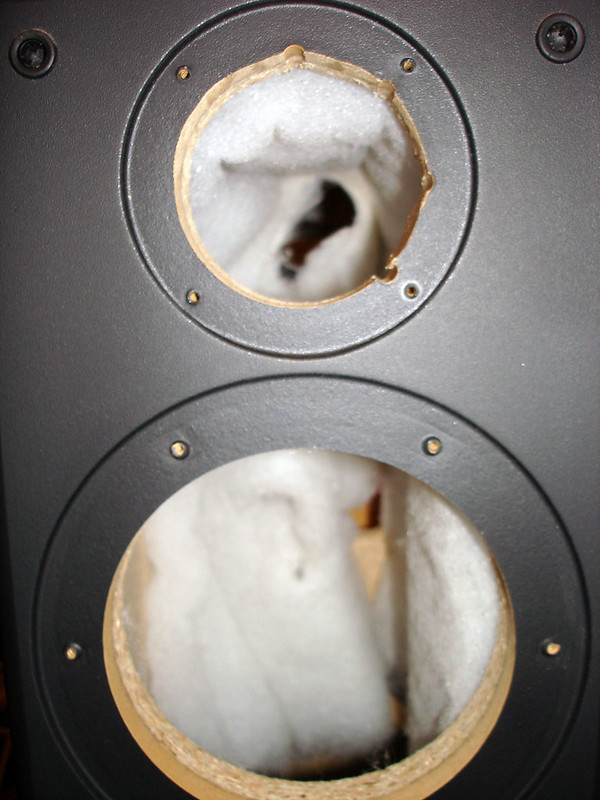 Lots of BAF wadding !  Here you can see the baffle is 2x thickness, another nice unexpected touch.  Here is a view from the top of the cabinet [internal] looking toward the bottom... As you can see its one large cavity, no dividers or sealed off parts as can be the case [Rega!] Just one decent brace beneath the midbass driver. 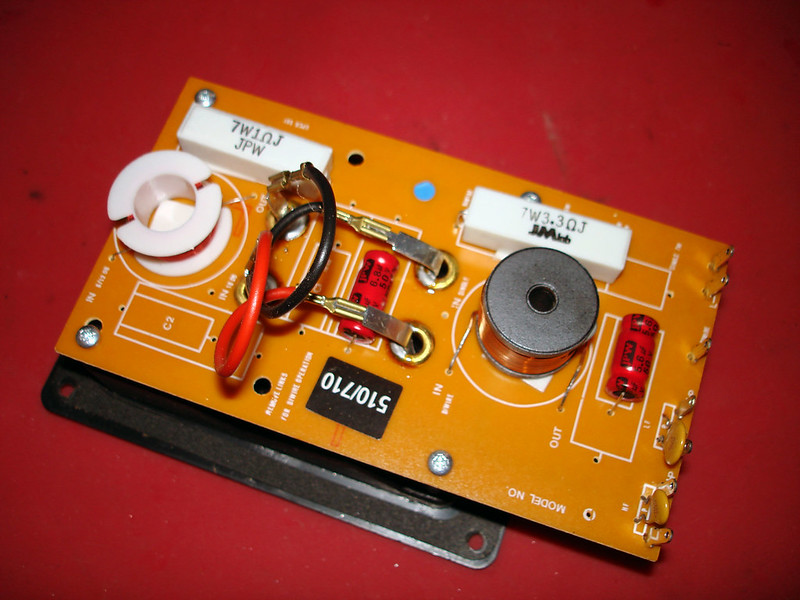 The crossovers, If the label is to be believed its shared between 510/710 models. Lots of crappy parts as expected, bipolar 'lyrics, ceramic resistors, ferrite-cored LF inductors & those nasty little PTC's :evil: At least they used an air-core on the HF section I suppose. 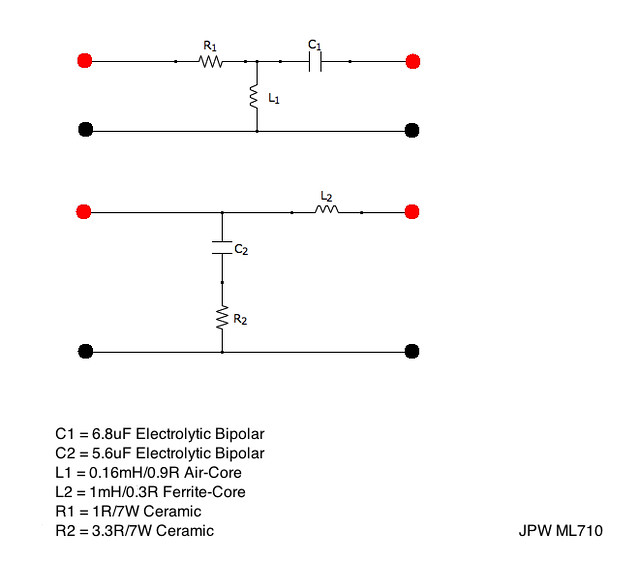 This is what the crossover actually is... Please excuse the terrible quality but I'm struggling to find a decent [free] CAD program for OS X. So far I have removed the BAF wadding entirely, there is none left inside the cabinets & also removed the PTC fuses [they can be bypassed but I wanted rid of them completely!] Been listening for over an hour now... Initial impression is that they sound more "live" now, as if a little reverb has been added but they are more entertaining for it. More to come soon... |
|
|
|
Post by John on Feb 16, 2015 17:11:42 GMT
I think just replacing those crossover parts will make a big difference
|
|
|
|
Post by istari_knight on Feb 16, 2015 17:22:53 GMT
I think just replacing those crossover parts will make a big difference Too true ! I'm not sure what I'm going to tackle next... I think I should do the steel lining, tempting as it is to upgrade the existing crossover's I really want to get rid of them & try the minimalist approach [mechanical vs electrical] I'll keep an eye out for some spare drivers, the 510's come up for sale quite often... Then I can try the doped drivers with minimal crossover vs undoped with upgraded multiway crossovers... Unless of course I'm perfectly happy with the outcome in which case I won't bother  |
|
|
|
Post by istari_knight on Feb 16, 2015 22:03:41 GMT
|
|
|
|
Post by MartinT on Feb 17, 2015 7:03:07 GMT
Keep the chokes and replace the caps and resistors would be my approach.
|
|
|
|
Post by danielquinn on Feb 17, 2015 9:31:01 GMT
No no martin , chuck the lot out and dope  |
|
|
|
Post by istari_knight on Feb 17, 2015 10:50:19 GMT
That used to be my standard approach Martin but the whole point of this is for me to learn why some prefer doing it differently  I'm currently umming and ahhing over what to use for doping compound, I know those who've gone before me used a contact adhesive that drys "flexible" for adding large amounts of mass/damping and a spray on rubber/plastic for small amounts of mass/damping but I'm not quite happy with the cosmetic result [yes I'm a tart  ] I think I've found a viable alternative that will result in the "shiny black gunk" look that Royd went for... Time will tell ! |
|
|
|
Post by istari_knight on Feb 17, 2015 12:34:21 GMT
Currently playing with the ports using PVC pipe... According to an online calculator the cabinets have an internal volume of 22L so the stock ports by their diameter/length are tuned to 20Hz - Seems low but these do make a fair bit of "whoompa whoompa" noise on material with sub bass. I initially increased the port length from 1" to 8"  which actually decreased LF output which I wasn't expecting, chopped down to 4" & tried again... LF is now boosted at the expense of smeared midrange & honky bass notes. I've now removed the pipes & stuffed the original 1" ports with the BAF wadding I removed from the cabinets yesterday, seems to be a great use for it  . The whole midrange has cleaned up tremendously although the bass is lighter its not a significant reduction [it doesn't help I currently have them 3ft from the rear wall so there is no boundary reinforcement]. For overall sound quality, sealed appears to be the way forward unless your a bass junky. |
|
|
|
Post by ChrisB on Feb 17, 2015 13:59:30 GMT
Big fan of the early ARs over here. I'd expect your proposal to add steel to the cabinets will help to return some of that lost bass. Then you'll have quality and quantity.
I've never put steel inside a cabinet but I have used it to add mass and stability to floorstanders by attaching 2x6mm thick sheets of it to the bases of the cabinets - one of the most cost effective modifications I have ever done.
|
|
|
|
Post by istari_knight on Feb 17, 2015 15:54:46 GMT
I like the later AR's too ! Cheaper cabinets than the early one's but still sound pretty good  . I've done some more playing [got nothing better to do !] Lacking doping or steel all I could look at was the crossovers... I stripped out the PCB's - What a PITA that was. 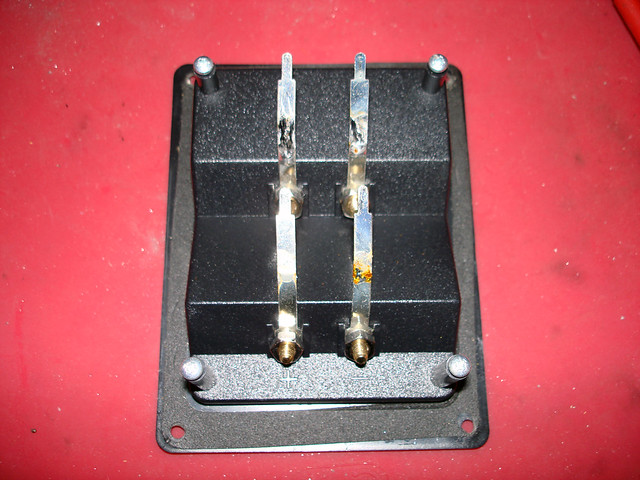 Then after rummaging through my parts box came back with a selection of BP capacitors ['lyrics unfortunately, but good one's] and a pair of inductors left over from an upgrade. Started with the tweeter: 3.3uF = Terrible vocal suckout makes women sound like men ! 6.8uF = Sounds just right to me. 10uF = too much information for the tweeter to handle, not good. So sticking with 6.8uF for now but will have to fine tune again +/- a couple of uF before buying polypropylene's in the right value. The inductors out of my spares box were 0.74mH, after punching the numbers in on some online "crossover calculators" I would need a value of 0.215mH for a 3000Hz crossover so I unwound them until the meter read the magic number. I appear to have got lucky with my choice of value as they sound just right without any faffing around - Bonus  Of course the inductors won't be staying after the mid bass drivers have been treated with doping compound. This was just a proof of concept to see how they sound with the simplest crossover possible and the result is astounding... The low frequencies have such attack, presence, dynamic thwack it knocked me for six when I first fired them up ! Any hint of midrange honkyness that was present with the original crossover has vanished aswell... The treble still isn't quite to my taste, too "zingy" but that may be the series 'lytics ? Or maybe it really needs a 2nd order ? I dunno yet.
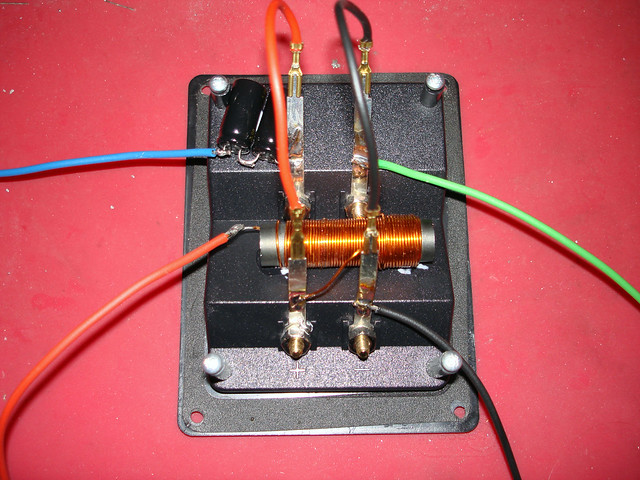
Keep tuned  |
|
|
|
Post by John on Feb 17, 2015 16:39:54 GMT
Great result
|
|
|
|
Post by MartinT on Feb 18, 2015 7:06:38 GMT
Nice result, James. Try bypassing the 'lytics with a polypropylene of good quality like a Supersound or Claritycap?
|
|
|
|
Post by istari_knight on Feb 18, 2015 11:02:24 GMT
I've tried bypassing them with some standard MKP's and there is a small improvement but just before giving up for the day I made a breakthrough... I've discovered that every time you make a change to a crossover you have to reposition the speaker from scratch... Seems obvious in hindsight ! Learn something new every day.
I was moaning about the tweeters but having now toed them in so I can just see the outside cabinet walls the fizzle has completely gone. I think this positioning combined with some decent cap's will be alright.
|
|
|
|
Post by danielquinn on Feb 18, 2015 11:14:59 GMT
You have highlighted why IMO an anechoically flat frequency response measurement is about a useful to a speaker purchaser as the two toilets in our house are to baby DQ .
|
|
|
|
Post by istari_knight on Feb 18, 2015 19:42:46 GMT
Indeed, there's just too many variables. The moment you put them in your listening room the FR is all over the place regardless of how great it was in the anechoic chamber... Move them slightly & its completely different again ! Drivers prepped & ready for doping.  |
|
 Just picked them up & they're in mint condition, so far so good ! Currently connected to a Sony TA-F770ES & being given a right good spanking they really come to life with a proper amp behind them [original owner demoed them using an Argos Goodmans 5.1 "thing"
Just picked them up & they're in mint condition, so far so good ! Currently connected to a Sony TA-F770ES & being given a right good spanking they really come to life with a proper amp behind them [original owner demoed them using an Argos Goodmans 5.1 "thing"  ] Initial listening is very promising indeed, they are well balanced [no particular part of the frequency spectrum stands out like a sore thumb] mids are a bit recessed/boxy & the treble turns cymbal crashes into dustbin lids - No, I'm being harsh its not that bad but there is room for improvement, which leads me onto why I bought these in the first place...
] Initial listening is very promising indeed, they are well balanced [no particular part of the frequency spectrum stands out like a sore thumb] mids are a bit recessed/boxy & the treble turns cymbal crashes into dustbin lids - No, I'm being harsh its not that bad but there is room for improvement, which leads me onto why I bought these in the first place... On the to-do list:
On the to-do list:


 Just picked them up & they're in mint condition, so far so good ! Currently connected to a Sony TA-F770ES & being given a right good spanking they really come to life with a proper amp behind them [original owner demoed them using an Argos Goodmans 5.1 "thing"
Just picked them up & they're in mint condition, so far so good ! Currently connected to a Sony TA-F770ES & being given a right good spanking they really come to life with a proper amp behind them [original owner demoed them using an Argos Goodmans 5.1 "thing"  ] Initial listening is very promising indeed, they are well balanced [no particular part of the frequency spectrum stands out like a sore thumb] mids are a bit recessed/boxy & the treble turns cymbal crashes into dustbin lids - No, I'm being harsh its not that bad but there is room for improvement, which leads me onto why I bought these in the first place...
] Initial listening is very promising indeed, they are well balanced [no particular part of the frequency spectrum stands out like a sore thumb] mids are a bit recessed/boxy & the treble turns cymbal crashes into dustbin lids - No, I'm being harsh its not that bad but there is room for improvement, which leads me onto why I bought these in the first place... On the to-do list:
On the to-do list:















 which actually decreased LF output which I wasn't expecting, chopped down to 4" & tried again... LF is now boosted at the expense of smeared midrange & honky bass notes. I've now removed the pipes & stuffed the original 1" ports with the BAF wadding I removed from the cabinets yesterday, seems to be a great use for it
which actually decreased LF output which I wasn't expecting, chopped down to 4" & tried again... LF is now boosted at the expense of smeared midrange & honky bass notes. I've now removed the pipes & stuffed the original 1" ports with the BAF wadding I removed from the cabinets yesterday, seems to be a great use for it 

